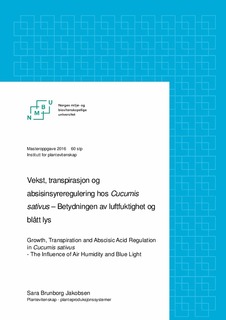| dc.contributor.advisor | Torre, Sissel | |
| dc.contributor.author | Jakobsen, Sara Brunborg | |
| dc.date.accessioned | 2016-08-09T11:26:36Z | |
| dc.date.available | 2016-08-09T11:26:36Z | |
| dc.date.issued | 2016-08-09 | |
| dc.identifier.uri | http://hdl.handle.net/11250/2398439 | |
| dc.description.abstract | Planter som er dyrket under høy relativ luftfuktighet (RF) utvikler spalteåpninger som mangler evnen til å lukke ved ytre stimuli. Hormonet absisinsyre (ABA) er et viktig signal for lukking av spalteåpninger. Denne studien har sett på effekten av blått lys (B) på plantenes innhold av ABA og dens metabolitter. I tillegg er det undersøkt hvordan B påvirker plantenes morfologi og klorofyllinnhold. RF og mengde B, og samspillet mellom disse, ble testet på planter av tomat (Solanum lycopersicum) og agurk (Cucumis sativus). Forsøkene ble utført i vekstkammer, og avsluttet før plantene hadde utviklet full fruktproduksjon. Under det to uker lange forsøket stod plantene i vekstkammer med 60 % RF eller 90 % RF, i kombinasjon med enten høytrykksnatriumlamper (SON-T, 5 % B) eller SON-T + B lysdioder (LED) (30 % B).
Plantene som ble dyrket under 90 % RF hadde et lavere klorofyllinnhold og utviklet klorose. Det var en sammenheng mellom innholdet av klorofyll og nitrogen i bladene. Ved dyrkning under 30 % B ble den negative effekten under 90 % RF reversert ved å øke klorofyllinnholdet i plantene. Økt andel B økte transpirasjonsraten til plantene og dermed opptaket av viktige næringsstoffer som nitrogen og fosfor. Plantene dyrket under 60 % RF + 30 % B var minst og hadde en lavere tørrstoffakkumulasjon sammenlignet med de andre behandlingene. Under 90 % RF var det ingen forskjell i tørrstoffakkumulasjon når plantene var dyrket under de ulike andelene B.
Det var ingen forskjell i mengde ABA mellom høy og moderat RF men planter dyrket med ekstra B inneholdt mindre ABA enn planter dyrket ved SON-T. Spalteåpningene var også mer åpne under ekstra blått lys. Ved dyrkning under 90 % RF ble plantene stimulert til å inaktivere absisinsyre (ABA) mot phaseinsyre (PA) og diphaseinsyre (DPA). Ved dyrkning under 30 % B ble plantene stimulert til å inaktivere ABA mot absisinsyre-glukosyl-ester (ABA-GE) som er en lagringsform av ABA, i motsetning til 5 % B som gav inaktivering mot PA og DPA. Resultatene tyder på at B øker plantenes mulighet til å oppregulere ABA raskt.
Resultatene i denne studien viser at ekstra blått lys kan gi plantene mulighet til å utnytte de gode vekstvilkårene under høy RF, samtidig som de unngår problemer med spalteåpninger som mangler lukke-evne. | nb_NO |
| dc.description.abstract | Previously studies have shown that plants produced under high relative humidity (RH) develop malfunctioning stomata, which fail to close under stressed situations. The closing mechanism of stomata is largely regulated by the hormone abscisic acid (ABA). This study examined the effect of blue light (B) on ABA and its metabolites of the plant as well as the morphology of the plants. The combined effects of relative air humidity (RH) and the amount of blue light were tested on tomatoes (Solanum lycopersicum) and cucumber (Cucumis sativus). The experiments were conducted in four controlled environment growth chambers and repeated two times. Plants in growth chambers were either exposed 60% RF or 90% RF, and in combination with high-pressure sodium lamps (HPS, 5 % B) or HPS + light emitting diode (LED, 30 % B).
The amount of chlorophyll was low in the plants grown under 90 % RH with HPS and they developed chlorosis. When the plants were exposed to 30 % B, the negative effects of 90 % RH were reversed by increasing the chlorophyll content in the leaves. 30 % B increased the plant transpiration, subsequently affecting uptake of important nutrient as nitrogen and phosphorus. The plants grown under 60 % RH + 30 % B were the smallest plants and they had the lowest accumulation of dry weight. This was not the case for 90 % RH + 30 % B, which showed almost similar dry weight accumulation as plants produced in 90% RF + HPS.
The level of total ABA was highest in plants grown under 90% RH compared to 60 % RH. Plants developed under 30% B had a lower level of total ABA compared to 5 % B, in addition the stomatas had higher aperture when grown under 30% B. When plants were exposed to 90 % RH they inactivated ABA towards phaseic acid (PA) and diphaseic acid (DPA). Plants grown under 30 % B was stimulated to inactivate ABA towards abscisic acid glucosyl ester (ABA-GE), while 5 % B inactivated ABA towards PA and DPA. It is possible that the use of extra blue light improves the closing ability of the stomata caused by a high proportion of stored ABA-GE, which can be converted to active ABA.
Use of extra B can enable the plants to better utilize the good growing conditions provided by high RH and in addition avoid the negative effect of high RH on the stomata. | nb_NO |
| dc.language.iso | nob | nb_NO |
| dc.publisher | Norwegian University of Life Sciences, Ås | |
| dc.subject | Luftfuktighet | nb_NO |
| dc.subject | Blått lys | nb_NO |
| dc.subject | Absisinsyre | nb_NO |
| dc.subject | Phaseinsyre | nb_NO |
| dc.subject | Diphaseinsyre | nb_NO |
| dc.subject | absisinsyre-glukosyl-ester | nb_NO |
| dc.subject | Solanum lycopersicum | nb_NO |
| dc.subject | Cucumis sativus | nb_NO |
| dc.title | Vekst, transpirasjon og absisinsyreregulering i Cucumis sativus : betydningen av luftfuktighet og blått lys | nb_NO |
| dc.title.alternative | Growth, Transpiration and Abscisic Acid Regulation in Cucumis sativus : The Influence of Air Humidity and Blue Light | nb_NO |
| dc.type | Master thesis | nb_NO |
| dc.source.pagenumber | 84 | nb_NO |
| dc.description.localcode | M-PV | nb_NO |
